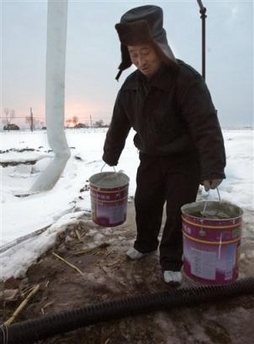|
China getting US help with toxic spill
(AP)
Updated: 2005-12-07 15:20
The United States said Tuesday it was sending experts to help China limit
damage from a toxic spill in a river, while Beijing promised to work closely
with Moscow to cope with the chemicals flowing toward Russia's Far East.

A Chinese man draws
water from an underground well for consumption as authorities shut down
the water supply in Zhulian village near Jiamusi, Heilongjian province,
northern China, Tuesday, Dec. 6, 2005. A slick of toxic benzene, which
spilled into the river after a Nov. 13 chemical plant explosion, causing
cities along the river to shut down water plants, is expected to arrive in
Jiamusi Tuesday. [AP] |
The expanded cross-border efforts to limit damage came as this city of
480,000 people in China's northeast rushed a new water plant into operation
following the shutdown of another facility near the river for fear of
contamination.
U.S. Ambassador Clark T. Randt said Beijing accepted Washington's offer to
send a team from its Environmental Protection Agency.
"We are sending to China an environmental impact assessment team," Randt told
a group of business leaders in Hong Kong. He said they would "help make
suggestions on remediation efforts."
Beijing has apologized to Moscow for the spill caused by a Nov. 13 chemical
plant explosion. It is expected to reach Khabarovsk, a border city with 580,000
people, early next week.
In a letter this week to his Russian counterpart, Chinese Premier Wen Jiabao
"reaffirmed China's readiness to further cooperate with Russia to deal with the
aftermath of the pollution," said Qin Gang, a Chinese Foreign Ministry
spokesman.
Harbin shut down running water for five days, allowing the residents to get
water from tanker trucks and hotels, restaurants, factories and other
businesses.
The director of China's environmental protection agency has resigned and the
general manager of the chemical company blamed for the spill was removed from
his post.
The spill reached Jiamusi early Tuesday, said a spokesman for the
Environmental Protection Office of Heilongjiang province, where the city is
located. He would give only his surname, Wu.
The concentration of nitrobenzene, one of the toxins in the slick, were more
than eight times the safe level, the Xinhua News Agency said.
The chemical slick, now some 90 miles long, has been lengthening and slowing
as the Songhua freezes over.
|